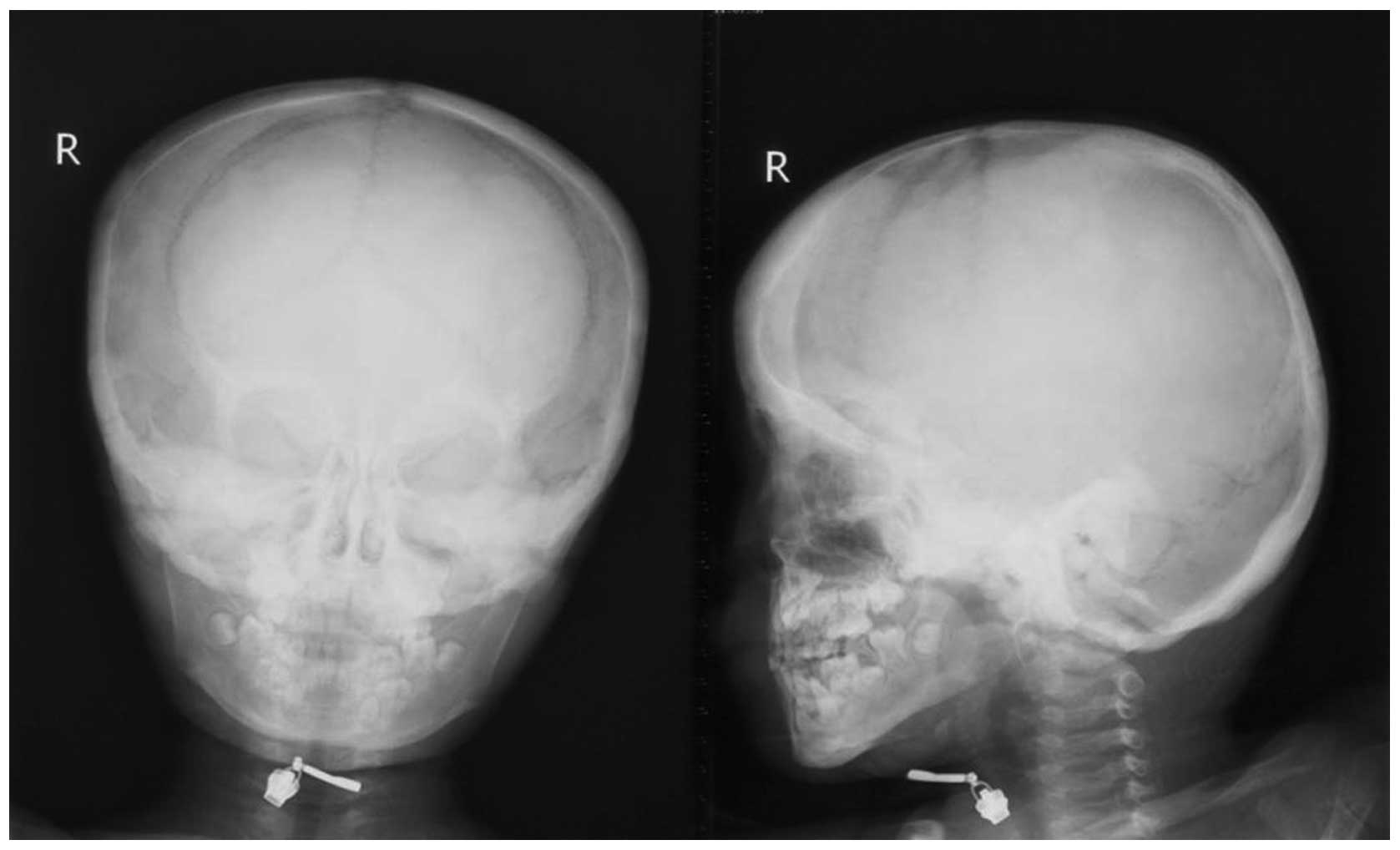|
1
|
de Vernejoul MC: Sclerosing bone
disorders. Best Pract Res Clin Rheumatol. 22:71–83. 2008.
|
|
2
|
Ralston SH: Genetics of osteoporosis. Ann
NY Acad Sci. 1192:181–189. 2010. View Article : Google Scholar : PubMed/NCBI
|
|
3
|
Janssens K, Vanhoenacker F, Bonduelle M,
Verbruggen L, Van Maldergem L, Ralston S, Guañabens N, Migone N,
Wientroub S, Divizia MT, Bergmann C, Bennett C, Simsek S, Melançon
S, Cundy T and Van Hul W: Camurati-Engelmann disease: review of the
clinical, radiological, and molecular data of 24 families and
implications for diagnosis and treatment. J Med Genet. 43:1–11.
2006. View Article : Google Scholar : PubMed/NCBI
|
|
4
|
Liang YH, Li W, Li LY, Ye YY and Lu GX: A
mutation in TGF beta1 gene encoding the latency-associated peptide
in a Chinese patient with Camurati-Engelmann disease. Zhonghua Yi
Xue Yi Chuan Xue Za Zhi. 23:502–504. 2006.(In Chinese).
|
|
5
|
Gu JM, Zhang ZL, Zhang H, Hu WW, Wang C,
Yue H, Ke YH, He JW, Hu YQ, Li M, Liu YJ and Fu WZ: Thirteen
Chinese patients with sporadic Paget’s disease of bone: clinical
features, SQSTM1 mutation identification, and functional analysis.
J Bone Miner Metab. 30:525–533. 2012.
|
|
6
|
Gao G, Zhang ZL, Zhang H, Hu WW, Huang QR,
Lu JH, Hu YQ, Li M, Liu YJ, He JW, Gu JM and Yu JB: Hip axis length
changes in 10,554 males and females and the association with
femoral neck fracture. J Clin Densitom. 11:360–366. 2008.
View Article : Google Scholar : PubMed/NCBI
|
|
7
|
Zhang ZL, He JW, Qin YJ, Hu YQ, Li M,
Zhang H, Hu WW, Liu YJ and Gu JM: Association between myostatin
gene polymorphisms and peak BMD variation in Chinese nuclear
families. Osteoporos Int. 19:39–47. 2008. View Article : Google Scholar : PubMed/NCBI
|
|
8
|
Wu XP, Yang YH, Zhang H, Yuan LQ, Luo XH,
Cao XZ and Liao EY: Gender differences in bone density at different
skeletal sites of acquisition with age in Chinese children and
adolescents. J Bone Miner Metab. 23:253–260. 2005. View Article : Google Scholar : PubMed/NCBI
|
|
9
|
Liao EY, Wu XP, Deng XG, Huang G, Zhu XP,
Long ZF, Wang WB, Tang WL and Zhang H: Age-related bone mineral
density, accumulated bone loss rate and prevalence of osteoporosis
at multiple skeletal sites in chinese women. Osteoporos Int.
13:669–676. 2002. View Article : Google Scholar : PubMed/NCBI
|
|
10
|
Vanhoenacker FM, Janssens K, Van Hul W,
Gershoni-Baruch R, Brik R and De Schepper AM: Camurati-Engelmann
disease. Review of radioclinical features. Acta Radiol. 44:430–434.
2003.PubMed/NCBI
|
|
11
|
Campos-Xavier B, Saraiva JM, Savarirayan
R, Verloes A, Feingold J, Faivre L, Munnich A, Le Merrer M and
Cormier-Daire V: Phenotypic variability at the TGF-beta1 locus in
Camurati-Engelmann disease. Hum Genet. 109:653–658. 2001.
View Article : Google Scholar : PubMed/NCBI
|
|
12
|
Janssens K, Gershoni-Baruch R, Guañabens
N, Migone N, Ralston S, Bonduelle M, Lissens W, Van Maldergem L,
Vanhoenacker F, Verbruggen L and Van Hul W: Mutations in the gene
encoding the latency-associated peptide of TGF-beta 1 cause
Camurati-Engelmann disease. Nat Genet. 26:273–275. 2000. View Article : Google Scholar : PubMed/NCBI
|
|
13
|
Simsek S, Janssens K, Kwee ML, Van Hul W,
Veenstra J and Netelenbos JC: Camurati-Engelmann disease
(progressive diaphyseal dysplasia) in a Moroccan family. Osteoporos
Int. 16:1167–1170. 2005. View Article : Google Scholar : PubMed/NCBI
|
|
14
|
Wu S, Liang S, Yan Y, Wang Y, Li F, Deng
Y, Huang W, Yuan W, Luo N, Zhu C, Wang Y, Li Y, Liu M and Wu X: A
novel mutation of TGF beta1 in a Chinese family with
Camurati-Engelmann disease. Bone. 40:1630–1634. 2007. View Article : Google Scholar : PubMed/NCBI
|
|
15
|
Saito T, Kinoshita A, Yoshiura K, Makita
Y, Wakui K, Honke K, Niikawa N and Taniguchi N: Domain-specific
mutations of a transforming growth factor (TGF)-beta 1
latency-associated peptide cause Camurati-Engelmann disease because
of the formation of a constitutively active form of TGF-beta 1. J
Biol Chem. 276:11469–11472. 2001. View Article : Google Scholar
|
|
16
|
Janssens K, ten Dijke P, Ralston SH,
Bergmann C and Van Hul W: Transforming growth factor-beta 1
mutations in Camurati-Engelmann disease lead to increased signaling
by altering either activation or secretion of the mutant protein. J
Biol Chem. 278:7718–7724. 2003. View Article : Google Scholar
|
|
17
|
Tang Y, Wu X, Lei W, Pang L, Wan C, Shi Z,
Zhao L, Nagy TR, Peng X, Hu J, Feng X, Van Hul W, Wan M and Cao X:
TGF-beta1-induced migration of bone mesenchymal stem cells couples
bone resorption with formation. Nat Med. 15:757–765. 2009.
View Article : Google Scholar : PubMed/NCBI
|
|
18
|
Nishimura G, Nishimura H, Tanaka Y, Makita
Y, Ikegawa S, Ghadami M, Kinoshita A and Niikawa N:
Camurati-Engelmann disease type II: progressive diaphyseal
dysplasia with striations of the bones. Am J Med Genet. 107:5–11.
2002. View Article : Google Scholar : PubMed/NCBI
|












